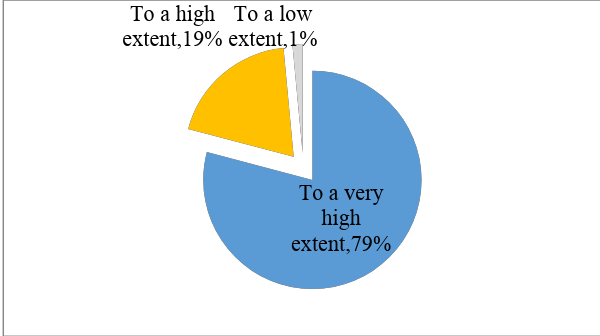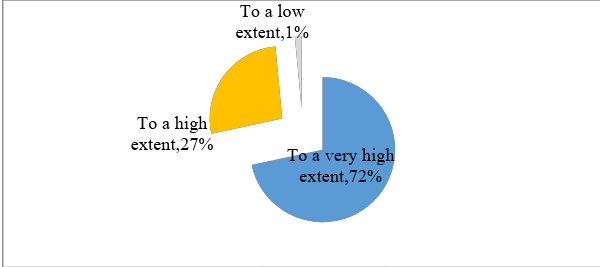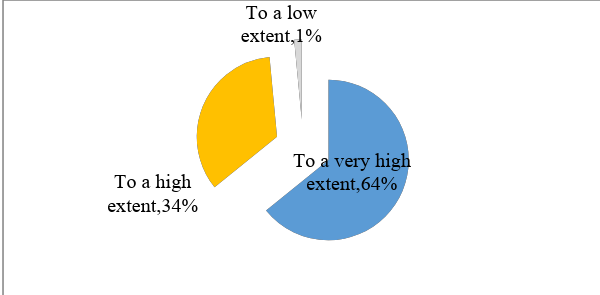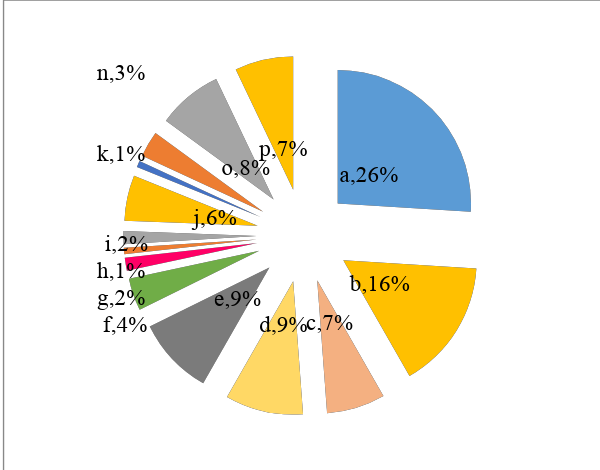Abstract
Although the role of health education is widely recognized in promoting and maintaining of a good health status, it can be noticed that a fairly large proportion of children - youngers and adults - do not express basic knowledge and skills concerning health and food education. In this respect, an important component of health education - nutrition education - seen as a conjunction of various educational strategies, together with a clear environmental support, designed to make easier and with full knowledge the food choices and nutrition related behaviors, with the view to promote health and well-being, becomes “a must” and a real urgency in the process of educating children and teen-agers. Answering to the actual needs concerning the strengthening of the importance of nutrition education in schools, the Erasmus+ European project entitled “Raising the Awareness of the Triad Nutrition-Health-Food Safety in School Education”, proposed a 15-credits teacher training program entitled: “Modern Approaches in Health Education” - consisted of two sections: (a) Innovative Aspects related to Teaching and Learning in Health Education, and (b) Actual Challenges in Food Science - which tried to enrich the primary and secondary teachers’ knowledge concerning food and related issues, to present suitable pedagogical strategies for designing health education activities and to produce didactic materials and guidelines able to sustain the optimal projection of teaching activities. In this sense, the paper tries to illustrate the feedback offered by the Romanian trained teachers, related to the entire training process, expressed at the moment of their graduation.
Keywords: Erasmus+ projectfood choiceshealth Educationnutrition behaviourteacher training program
Introduction
Children’s nutrition and food safety represent real challenges around the world, due to a considerable number of factors influencing them, such as early education, access to food (in socio-economic terms), parents’ practices related to food, higher offer of food within the commercial area in developed countries or food neophobia - recently emphasized in mass-media channels. A lack of conscious food education leads to unhealthy choice of food, to limited access to nutritious meals or to increasing risk of consumption of contaminated food. On the other hand, education plays a crucial role in the process of sustainable development. In this respect, a more evidence-based knowledge is needed in children’s health education. However, health education still tends to be dominated by an approach designed to achieve individual behaviour changes through the provision of knowledge, in order to avoid risk (Wright, O’Flynn, & Welch, 2018). In this sense, the teachers’ main task is to aid students on developing a sound knowledge base, and particularly, in science education, the teachers’ challenge is to illustrate things that cannot be seen, being useful to connect daily-life experiences of students to school science practice. In that way, the teachers should be trained in the organized formats related to their continuous training programs, so that to update their knowledge and to better adapts their didactic approach to the large topics of Health Education. The continuous professional development (CPD) is described as an “important professional life investment” or “renewal/refreshment” (Day, Sammons, Stobart, Kington, & Gu, 2007). Implementation of a new food literacy curriculum provides multiple health and social benefits to school students (Nanayakkara, Margerison, & Worsley, 2018). The teachers’ perceptions about the new curriculum contents, barriers and challenges in delivering, are basically for the success of its implementation.
Problem Statement
Health Education is nowadays a complex and controversial subject, a lot of actors and stakeholders expressing their opinion related to its importance and position within the curriculum. Part of them agrees that different disciplines already cover the content elements related to Health Education, without being necessary to take into account distinctive methods and tools of teaching, while another part thinks that it should be taught as distinct and compulsory discipline. All the involved parties consider that students should improve their knowledge within different subjects connected to Health Education in order to become healthy adults, with a wellbeing status during their entire life.
Research Questions
In the frame of the Erasmus+ European project entitled “Raising the Awareness of the Triad Nutrition-Health-Food Safety in School Education”, a 15-credits training program dedicated to primary and secondary teachers was proposed, being oriented on several themes gathered under the umbrella of “Modern Approaches in Health Education”, with two particular sections: (a) Innovative Aspects related to Teaching and Learning in Health Education, and (b) Actual Challenges in Food Science. The training program was designed as result of a Needs Analysis, so that to fulfil the teachers’ expectations related to Health Education in general, and nutrition and food safety topics in particular. After the ending of the training sessions, two research questions were formulated:
1. What were the main achievement of the training experience in terms of learning goals and professional development of the primary and secondary teachers?
2. What aspects of the training program can be improved, so that such programs in the area of Health Education to be more effectively, to really target on the needs expressed by the teachers, and to maximize their contribution to teachers’ professional development?
Purpose of the Study
The research took into consideration the feedback of the teachers from primary and secondary education, after the graduation of the 60-hours training program entitled “Modern Approaches in Health Education”, related to various aspects of the training process, with the view to enlighten on the most suitable methods and tools used in the frame of Health Education classes and to underline the importance of teacher training in the area of Nutrition Education.
Research Methods
A structured interview was administered in March 2014, to a total of 67 teachers - 42 from primary education and 25 from secondary education - who graduated the abovementioned training program, who answered to a questionnaire designed by the evaluation team of the project. 14 questions were included - 10 with four steps to answer shortly (from “to a very high extent” to “not at all”). For two questions, referring to the participation to the program and the modality of evaluation, the teachers were asked to answer with yes, no or I don’t know, while the last two questions offered the possibility to choose between 6 and 16 variants of answers. For the last two questions, only one, respectively two options of answers, were asked to be checked.
Findings
In the initial phase of the training program, there were established the proper ways for communication between teachers and program organizers, in terms of location, schedule or possible changes.
A lot of definitions were given to participation, considered to be a multidimensional and complex concept, influenced by situational and contextual issues (Stålberg, Sandberg, Larsson, Coyne, & Söderbäck, 2018). Teachers’ participation supposes reciprocal actions, between the teachers enrolled in the training program and their trainers (university teachers), involving verbal and nonverbal communication. Thus, communication represents a key issue for a successful approaching of the teaching-learning-evaluation process, being compulsory to establish the main pillars of the planned activity. The trained teachers were coming both from urban and rural area, for about 20% of them the distance between their home and the location of courses and labs representing a challenge, especially in the winter period. Moreover, their professional tasks required afternoon time spent in schools. On the other hand, for the university trainers, people with experience and expertise in pedagogy, sociology, applied informatics and food science, acting as trainers in the frame of the abovementioned program, it was important to design the schedule so that to facilitate the access and presence of all those enrolled in all the activities foreseen in the program, approved by the Ministry of Education. The connection between trainees and trainers with a view to ensure a proper communication over the months of activity, from the technical point of view, and later from the scientific one too, was considered vital. 88.06% from respondents appreciated as “very good” the communication related to the program organization, while for 11.94% from teachers this issue was simply “good”.
The courses, seminars, ICT-based activities and practical training activities were scheduled in the own location of the program organizer, so that the equipment (video-projectors, flipcharts, computers, reagents, laboratories apparatus and so on) to be in enough numbers and also to the needed quality. 68.66% from the teachers considered to a very higher extent that the rooms where the program was held were suitable to the planned activity. In terms of feedback, this number compels the technical team of the organizer paying more attention to the location, so that to improve the rooms features and consequently the participants’ satisfaction.
The trainees were asked if their participation to projected activities was monitored by the training provider or by the trainers. Only one answer was given by all the 67 participants - “yes” -, proving how important was considered the teachers’ presence for acquiring the taught concepts, especially having in view that the group of teachers was heterogenous in terms of professional background: Chemistry, Biology, Technological Education and even Foreign Languages, the last category being admitted as target group due to the quality of class masters.
Figure

The training program “Modern Approaches in Health Education” was structured in two modules: (a) Innovative Aspects related to Teaching and Learning in Health Education (30 hours / 7 credits), and (b) Actual Challenges in Food Science (30 hours / 8 credits). The objectives of the first module were defined as follows: knowledge of the elements of specificity of modern education in the context of Health Education; development of the competences needed for applying specific methodology in the educational process during Health Education classes. For the second module, four objectives were established, as follows: knowledge and understanding of the notions regarding the structure and functions of the compounds of the living matter, respectively the functionality of the nutrients and their implications on the human health; acquiring theoretical and practical knowledge of potential food contaminants that can affect food safety; knowledge of the food labelling concept, with all related aspects, including the specific regulations established through the European legislation, respectively of its interrelations with the human health; knowledge of the good hygiene practices, necessary to reduce the risk of food contamination and spoilage, in order to preserve the health of consumers.
According to the data from Figure
Almost 50% of primary and secondary teachers agreed that the taught contents in the frame of the training program met their needs (Figure

Although the role of food products is widely recognized in promoting and maintaining a good health status, many studies draw the attention to the fact that a fairly large proportion of teenagers and adult population, in developed countries, do not have basic knowledge and skills on nutrition and food safety. Thus, nutrition education remains a need in the process of educating children and adolescents as an integral part of Health Education. It continues to be in school one of the main tools of promoting people health, through facilitating the acquisition of sound knowledge related to factors that influence health, and also through forming attitudes and skills indispensable for a responsible and healthy behavior.
The
identifying the perceptions of school managers and teachers concerning the implementation of the Health Education curriculum,
identifying the lack of knowledge related to nutrition, health and food safety topics,
identifying the methods and tools of teaching-learning-evaluation used in Health Education activities and their analysis from the perspective of the competencies that must to be acquired,
identifying the shortage of didactic and auxiliary materials needed for the optimal carrying on of the specific teaching activities related to Education for nutrition, health and food safety.
Having in view all the above-mentioned aspects, the training program was structured around topics such as:
- Module (a):
- Module (b):
Practical activities were proposed in the frame of both modules, so that to cover the needs of training in the area of Health education, as follows:
- Module (a): Competence-centred training; The specific of designing, organizing and carrying on the teaching activities within the Health Education discipline; The specific of the assessment within the Health Education discipline; Capitalizing of the ICT competences within the Health Education discipline
- Module (b): Methods of chemical analysis applied in qualitative and quantitative determination of nutrients from food; Rapid tests for determination of such contaminants (heavy metals, nitrates etc.) in food; Evaluation of freshness of animal food products (milk, meat and derived products); Nutritional labeling of food; Shelf life, list of ingredients and nutritional value of food; Recommended daily intake and other indicators of food consumption evaluation; Health logos in Europe; Sanitation tests applied in the food industry.

The teachers were questioned if the working methods used in the frame of the training program support learning (Figure
The abovementioned working methods were chosen so that to develop the critical inquiry approach of the teachers, having in view that this one educates to develop the children and young people capacity to engage critically their knowledge, through reasoning, problem solving and challenging taken for granted assumptions (Wright et al., 2018).
72% of the respondents agreed “to a very high extent” that the materials used as support for courses and practical training were useful (Figure

Teachers successfully made the use of ICT as a characteristic students’ empowerment as learners rather than receiving instruction. Schools can go only so far to encourage the ICT use, but the actual take-up depends largely on teachers’ personal feelings, skills and attitudes to ICT in general (Mumtaz, 2000).
The eighth question approached the subject of the acquired competencies (Figure
- Module (a):
- Module (b):
In order to meet the teachers’ needs and expectation, the training program was designed and implemented as a combination of face-to-face and online learning, being proved that the blended learning is, at least, as effective and equally satisfying for learners as traditional learning methods (Spanjers, Könings, & Leppink, 2015). Suitable teaching strategies were applied, focused on competencies to be acquired.
81% from the respondents considered that during the training process, the feedback was permanently requested, for 18% this one being a situation met “relatively frequent”. Related to the improvement of the training process on the basis of the offered feed-back, the answers were splitted between 61.2% - “to a very high extent”, 37.3% - “to a high extent” and 1.5% “to a low extent” respectively.

The feedback is compulsory for many reasons in the frame of the training process, its accuracy being also subject to research. According Bing-You et al. (2018), the exchange of the feedback is troubled by low-quality feedback, leniency bias, faculty deficient in feedback competencies, challenges with multiple feedback tools.
Evaluation represents the activity through which value judgments are emitted about the learning process and product, on the basis of predetermined qualitative criteria, in order to take decisions according to the significance given to the evaluation process: regulation / improvement, selection, certification etc. In the last decades, evaluation became one of the major issues in education. Multiple changes in social, political, economical concepts also determine changes within the evaluation dimension.
The trainees were asked if the evaluation over the time made in the frame of each topic offered to her / him information about the own progress (Figure

The thirteenth question was designed so that to explore the enunciation that best described the own situation of teachers, who were in a position to choose between 6 variants (only one variant was allowed to be checked). 60% of respondents agreed that “the training program seems useful to me”, 12% mentioned that “from what I learned in the frame of the training program, I tried to apply something in my teaching activity”, and 28% answered “from what I learned in the frame of the training program, I successfully applied two or three things in my didactic activity”. Nobody answered that the aim of the participation to the training program was linked to getting credits or “Few of the things learned in the program are a novelty for me” and “I have had restraints in applying in my teaching activity the things I learned at the course, because I still do not master them well enough” respectively.
The last question offered to participants 16 variants of answers, in order for them to choose two answers to the challenge formulated as follows: “

Nobody answered, “to collaborate more effectively with the school community” (l) and “to collaborate more effectively with colleagues in school” (m), while only 1% of the given answers was related to the improvement of the collaboration with the students’ families (k) and better achievement of the assessment of the students’ progress (h). A small number of teachers (2%) considered that after the training program, they will be able to offer a relevant feedback to students (g) and to better sustain the students with special needs (i), respectively to design the own teaching career more effectively (n - 3%). 4% answered that they will make a better selection of the content to be taught (f) and 6% to design a new curriculum (j).
Conclusion
The results showed that primary and secondary teachers engaged in the continuous professional development contexts proposed by the training program entitled: “Modern Approaches in Health Education” improved their knowledge related to Health Education in general, and Nutrition Education in particular, being aware that nowadays school health education curriculum employs teachers’ developmental tasks throughout their career, but also a clear critical inquiry approach. The teachers need more resources and guidance to increase their skills in applying suitable concepts and instructional methods, respectively their confidence in teaching Health Education to students.
Acknowledgments
The paper capitalizes some of the results obtained in the ERASMUS+ project - Strategic partnerships - code: 2014-1-RO01-KA200-002931 - “EduForHealth - Let’s make it better! Raising the awareness of the triad nutrition-health-food safety in school education”, funded with the support of the Erasmus+ programme of the European Union. The European Commission support for the production of this publication does not constitute an endorsement of the contents which reflects the views only of the authors, and the Commission cannot be held responsible for any use which may be made of the information contained therein.
References
- Bing-You, R., Varaklis, K., Hayes, V., Trowbridge, R., Kemp, H., & McKelvy, D. (2018). The Feedback Tango: An Integrative Review and Analysis of the Content of the Teacher–Learner Feedback Exchange, Academic Medicine, 93(4), 657-653, doi:
- Day, C., Sammons, P., Stobart, G., Kington, A., & Gu, Q. (2007). Teachers matter: Connecting work, lives and effectiveness. London: Open University Press.
- Louws, M.L., Meirink, J.A., van Veen, K., & van Driel, J.H. (2018). Understanding teachers’ professional learning goals from their current professional concerns, Teachers and Teaching, 24(1), 63-80, doi:
- Mumtaz, S. (2000). Factors affecting teachers’ use of information and communications technology: a review of the literature, Journal of Information Technology for Teacher Education, 9(3), 319-342, doi:
- Nanayakkara, J., Margerison, C., & Worsley, A. (2018). Teachers’ perspectives of a new food literacy curriculum in Australia, Health Education, 118(1), 48-61, doi:
- Schmoelz, A. (2018). Enabling co-creativity through digital storyelling in education, Thinking Skills and Creativity, 28, 1-13.
- Spanjers, I.A., Könings, K.D., & Leppink, J. (2015). The promised land of blended learning: quizzes as a moderator, Educational Resarch and Reviews, 15, 59-74.
- Stålberg, A., Sandberg, A., Larsson, T., Coyne, I., & Söderbäck, M. (2018). Curious, thoughtful and affirmative - Young children's meanings of participation in healthcare situations when using an interactive communication tool, Journal of Clinical Nursing, 27, 235-246.
- Wright, J., O’Flynn, G., & Welch, R. (2018). In search of the socially critical in health education: Exploring the views of health and physical education preservice teachers in Australia, Health Education, 118(2), 117-130, doi:
Copyright information

This work is licensed under a Creative Commons Attribution-NonCommercial-NoDerivatives 4.0 International License.
About this article
Publication Date
09 April 2019
Article Doi
eBook ISBN
978-1-80296-059-4
Publisher
Future Academy
Volume
60
Print ISBN (optional)
-
Edition Number
1st Edition
Pages
1-1062
Subjects
Multicultural education, education, personal health, public health, social discrimination,social inequality
Cite this article as:
Buruleanu, C. L., & Gorghiu, G. (2019). A Tailored Food Science Education Program For Primary And Secondary Teachers. In E. Soriano, C. Sleeter, M. Antonia Casanova, R. M. Zapata, & V. C. Cala (Eds.), The Value of Education and Health for a Global, Transcultural World, vol 60. European Proceedings of Social and Behavioural Sciences (pp. 618-628). Future Academy. https://doi.org/10.15405/epsbs.2019.04.02.77

